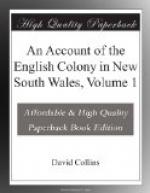The numbers employed at this work were as follow:
Invalids gathering the flax 3 men
Preparing it 7 women
Beating and washing it 3 who are invalids
Flax-dresser 1
Spinners 2 women
Weaver and assistant 2 men
—
Total 18
by whose weekly labour sixteen yards of canvas of the size of No 7 was made. It is to be remarked, that the women, and most of the men, could be employed at no other work; and that the labour of manuring and cultivating the ground; the loss of other crops; the many processes used in manufacturing the European hemp, and the accidents to which it is liable during its growth, are all, by using this flax, avoided, as it needs no cultivation, and grows in sufficient abundance on all the cliffs of the island (where nothing else will grow) to give constant employment to five hundred people. Indeed, should it be thought an object, any quantity of canvas, rope, or linen, might be made there, provided there were men and women, weavers, flax-dressers, spinners, and rope-makers, with the necessary tools; but destitute as our people were of these aids, all that could be done was to keep in employ the few that could be spared from other essential work. If a machine could be constructed to separate the vegetable covering from the flaxen filaments, any quantity of this useful article might be prepared with great expedition.




